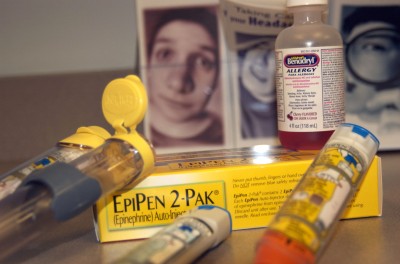
As soon as the bell rings for lunch, hundreds of students rush to the cafeteria to claim their spot in a line filled with people anxiously waiting to receive their daily fix of paninis, French fries, hamburgers, apples, and salads.
However, among this large student body, there exists a small subset of students who approach the lunch room with trepidation. These are the victims of food allergies.
Katie Saveliff ’11, was diagnosed with severe peanut allergies when she was three years old. Since then, she has had a lot of struggles coping with it on a daily basis.
“My food allergies have made me very cautious to everything and hesitant towards trying new foods and even trusting people,” Saveliff said.
Saveliff recalled traumatic experiences she had during air travel when she was younger.
Peanuts were being served on all the flights she would go on, thus causing her to have panic attacks during the flight due to the fear of her deadly allergies acting up.
Saveliff feels that her allergies have strongly impacted her life.
“I carry an epi pen everywhere I go. Fortunately, I’ve never had to use it,” Saveliff said.
“You must inject it into your leg when you’re experiencing anaphylaxis-the deadly reaction-and it releases epinephrine into the bloodstream which only eases breathing. It’s meant to buy you time before going to a hospital.”
While it is very common to accommodate people with food allergies to peanuts, people with lesser-known allergies have more trouble finding ways to work around it.
Andrew Gai ’11, who as of last year, has developed a food allergy to shellfish. Gai feels that his allergy is often not taken as seriously as more frequent allergies.
“It’s really frustrating, because most restaurants are prepared to deal with someone who is allergic to peanuts. When it comes to me, I just feel brushed aside,” Gai said.
“At times, I get worried that I can’t trust the restaurant. I always tell them that my food can not be contaminated with shellfish or anything that has touched shell fish whatsoever, but I can’t keep an eye on them.”
Gai also expressed the toll that his food allergies have taken on his social life.
“My friends joke about it a lot, like throwing pieces of shrimp at me just to see me dodge it. It’s not funny – I could die,” Gai said.
With those who have food allergies, their immune systems mistakenly identify a specific food or a substance in food as something harmful.
According to webmd.com, 55 percent of Americans have one or more allergies, although only 3 to 4 percent only have food allergies.
However, luckily there is hope. Corporations such as the Food Allergy Initiative are making an effort to find cures for life threatening food allergies.
Gai says that this possibility rejoices him. “Someday, I’ll be able to eat shrimp again.”












































